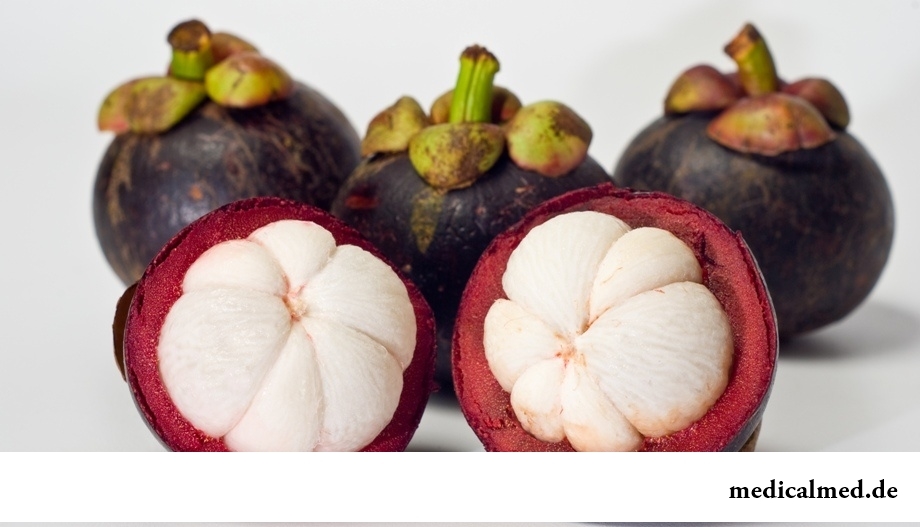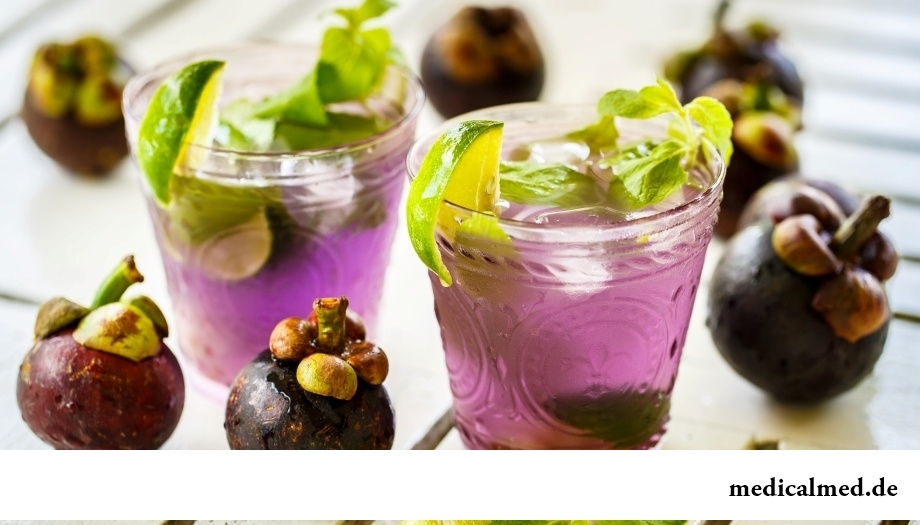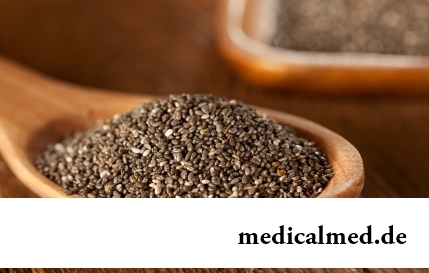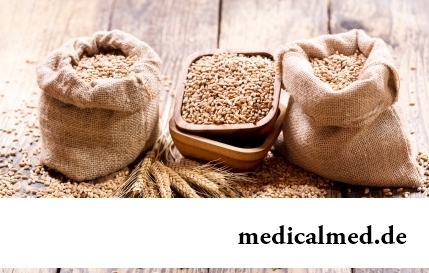





Mangostin
This фруктнастолько is popular in Asia that it was even given the royal status. And in the European countries bigger distribution was gained by juice of a mangostin.

Description
Mangostin – a plant from Kluziyev' family. Rod Mangostin from the region of Southeast Asia where he is eurysynusic also till today. Besides, this fruit is successfully grown up in Africa, South and Central America. His largest producers are Indonesia, Thailand, Cambodia, Vietnam, Myanmar, Malaysia, Sri Lanka, India, Honduras and Philippines.
Fruits of a mangostin have quite exotic appearance and refined taste. Rounded shape, fruits have a diameter 3,5-7,5 centimeters, and from above are covered smooth and thick (6-10 mm) with a peel which color fluctuates from dark-lilac to red-lilac. Under a peel there is a snow-white juicy pulp consisting of several segments. Each segment contains a quantity of seeds of an egg-shaped form, about 2,5 centimeters in size in length and 1,5 centimeters width. On taste pulp fragrant and sweet, with sourness, and it is possible to compare it to taste of strawberry, a peach, and grapes.
Use of a mangostin in cookery
Thanks to the useful properties, мангостин widely apply in cookery. Special distribution was gained by pulp of fruits and juice of a mangostin. According to reviews мангостин well is suitable for fruit and acute salads, milkshakes, sauces of a curry, a souffle, and also for fish and seafood.
In the countries of Southeast Asia eat as well seeds of a mangostin which fry or boil.
Structure and caloric content of a mangostin
In 100 g of a mangostin 80,8 g of water, 15,9 g of carbohydrates, 1,4 g of cellulose, 0,6 g of proteins, 0,6 g of fats, 0,5 g of ashes contain; vitamins: thiamin (B1), Riboflavinum (B2), Niacinum (RR), pantothenic acid (B5), pyridoxine (B6), folic acid (B9), sincaline (B4), ascorbic acid (C), tocopherol (E); microelements: fluorine, zinc, copper, manganese, iodine, iron; macrocells: chlorine, phosphorus, sulfur, magnesium, sodium, calcium, potassium.
Caloric content of a mangostin makes 72 kcal on 100 g of a product.
Useful properties of a mangostin
In the countries of Asia мангостин widely apply in traditional medicine. The peel which is previously dried up and crushed in powder is used as astringent, and also for treatment of fever and dysentery. Do paste which is applied to treatment of eczema and other diseases of skin of a peel. Broth from leaves and bark of a plant is used for treatment of diarrhea, urological diseases, dysentery and as an antipyretic. Thus, мангостин according to reviews helps at treatment of many diseases.

For quite some time now in America juice of a mangostin enjoys wide popularity. According to independent scientific research bark of fruits contains about 40 xanthones – the substances having strong antioxidant activity. Thanks to them juice possesses antifungal, antiviral, antiinflammatory action, carries out a role of an antibiotic and is useful to cardiovascular system. Juice of a mangostin is effective also at supertension, stones in kidneys, arthritis, a cataract, glaucoma, Alzheimer's disease, atherosclerosis. Drink it also for prevention from oncological diseases. Juice has ability to take off fatigue and to reduce appetite. It promotes combustion of fats and is useful at depressions, ulcers, a diarrhea, an allergy, neuralgia. It strengthens immunity and slows down processes of aging of an organism.
Having fallen from a donkey, you more likely will kill yourself, than having fallen from a horse. Only do not try to disprove this statement.

Practice of use of table salt in the therapeutic purposes contains not one century. Appl are considered especially effective...
Section: Articles about health
The saying "the rich do not know how the other half lives" is known to all. In a broad sense it is that we can not always understand the person whose features of a state are unknown to us. If with physiological characters of diseases the situation is more or less clearly (having noticed and...
Section: Articles about health
Antibiotics - - it is possible to call the chemical compounds suppressing growth of bacteria the break in the field of medicine which allowed to save mankind from many diseases incurable earlier: tuberculosis, plague, syphilis and many others. The contribution of drugs to rescue of people from epidemics of dangerous infections is huge, however at careless use antibiotics are capable to cause to an organism serious damage. Negative action can be shown in the form of easing of immunity, disturbance of balance of microflora in кишеч...
Section: Articles about health
For the person who daily since morning gathers for work it is very important to wake up vigorous and ready by day of work. On most...
Section: Articles about health
The immunity role in growth of the child is invaluable. The proteins-immunoglobulins produced by immune system preserve the child against the diseases capable − owing to an organism weak still − to serve as a stressful factor, to become the reason of many complications and delays in unless...
Section: Articles about health
The pancreas performs two functions in a human body: release of enzymes without which digestion of carbohydrates, fats and proteins, and a producing hormones is impossible. The most important of them - insulin, is the main participant of carbohydrate metabolism normalizing processes of education and utilization of glucose, the main energy source for an organism....
Section: Articles about health
Life expectancy in various regions of Earth is not identical. Exert impact on it social stability, economic бл...
Section: Articles about health
It is known that the person for 80% consists of water which participates in all processes of an organism. The person loses liquid daily – as a result of sweating, breath, an urination, and its insufficient completion due to various reasons can bring to обезвожив...
Section: Articles about health
Musicotherapy – a treatment method which caused and causes a set of a controversy concerning its efficiency. However the facts are relentless: during the numerous researches curative impact of music on an organism was scientifically confirmed. Since then in a number of the countries the technique is included complex therapy of diseases of cardiovascular and respiratory system, dorsodynias and a backbone, psychosomatic disturbances and many other illnesses. The musicotherapy in a pedi is especially widely applied...
Section: Articles about health
The chia plant, or the Spanish sage, is from South America. The indigenous people of the continent since ancient times used in food it семена:...
Section: Articles about health
The advantage of swimming for the person is so high that this sport is not only the most popular, but also is widely applied in medicine and rehabilitation processes. If you look for for yourself the occupation allowing pleasantly and to spend time, then swimming with advantage...
Section: Slideshow
The drugs stopping or oppressing life activity of pathogenic microorganisms are widely applied in clinical practice from 40th years of the last century. Originally antibiotics were called only substances natural (animal, vegetable or microbic) origins, but over time this concept extended, and it includes also semi-synthetic and completely artificial antibacterial drugs....
Section: Articles about health
It would seem, about it there can be no disagreements: water is necessary for a human body for normal zhiznedeyatet...
Section: Articles about health
Contrary to popular belief, the multiple sclerosis (MS) is not connected neither with sclerous changes of walls of vessels, nor with age forgetfulness and problems with concentration of attention. This disease has the autoimmune nature. Pathological process of a vyrazh...
Section: Articles about health
Aging — natural and inevitable process. Over time our skin loses elasticity, on it saggings are formed, the face form loses former clearness. The procedure of nitevy lifting (nitevy tightening) can successfully solve this problem. In order that it is better to get acquainted with this popular procedure, we will tell you 6 cognitive facts about it....
Section: Articles about health
All got used long ago that, having addressed the plastic surgeon, it is possible to modify natural parameters of a figure or to reduce...
Section: Articles about health
The medicine promptly develops, and the fact that else quite recently it seemed by miracle can now. We are not surprised any more to the fact that people with artificial joints and extremities can play sports, organ transplantation became a routine, and the latest cancer medicine п...
Section: Articles about health
Scientists always aimed to offer fundamental explanations for medical problems. Their theories formed the basis of modern methods of treatment of the hardest pathologies and helped to save a set of lives. However stories are known also such theoretical constructions, following to which brought to mankind of a trouble and torture, ruined destinies and health of many people....
Section: Articles about health
Bulimia and anorexia, are heavy deviations of a feeding behavior, become a cause of death of patients much more often than all others...
Section: Articles about health
The technique of acupuncture (acupuncture) is used in the medical purposes more than three and a half millennia. It is eurysynusic and recognized as official medicine in the majority of the developed countries of the world. Influence by fine needles on so-called points...
Section: Articles about health
Among a set of the perfumery and cosmetic goods which are released today the special group is made by the means containing antibacterial components. Such types of gels, shampoos, soaps, creams, lotions and other products are positioned by manufacturers as a panacea from all diseases caused by pathogenic microorganisms. The unlimited and uncontrolled use of similar means becomes result of trustfulness of the buyers hypnotized by persuasive advertizing sometimes. Many spetsial...
Section: Articles about health
Each failure in work of bodies and systems of a human body is, as a rule, shown by the whole complex of symptoms. In particular, N...
Section: Articles about health
The concept "gluten" (differently, a gluten) combines group of the proteins which are a part of rye, barley and wheat. For most of people the use of the food stuffs containing a gluten not only is safe, but also it is very useful. Nevertheless, there is a number the myth...
Section: Articles about health
Statistically cystitis 25-30% of women up to 40 years have. With age this indicator raises, besides many do not get to statistics because do not see a doctor. The most sad that after the regular visits to doctors, long reception of antibiotics and life in the mode "it is necessary to take care" cystitis all the same is returned to a half of women. Symptoms of cystitis are unambiguous and it is impossible to confuse them with anything: bladder pain, burning at an urination, frequent desires to go to a toilet, a vynuzhd...
Section: Articles about health
To look healthy and means well-groomed not only to be pleasant to people around, but also to feel strong, sure and taken place. To Spa...
Section: Articles about health
Zone hypostases under eyes - very widespread problem giving to people is a lot of inconvenience. Hypodermic fabric in these parts has very loose structure and almost does not contain collagenic fibers. Besides, the skin covering подглазья constantly is exposed...
Section: Articles about health
The mankind knows that some toxins at intake in the minimum quantities have therapeutic effect from an extreme antiquity. Many substances recognized poisonous are applied in the medical purposes also today, being the main operating components of the medicines which are officially produced by pharmaceutical industry. Let's tell only about the most known of them....
Section: Articles about health
